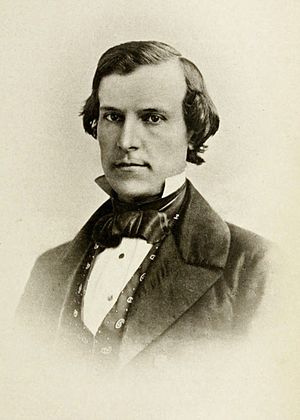George Hussey Earle Sr. facts for kids
Quick facts for kids
George Hussey Earle Sr.
|
|
|---|---|
 |
|
| Born | George Hussey Earle December 8, 1823 Philadelphia, Pennsylvania, United States |
| Died | June 18, 1907 (aged 83) Philadelphia, Pennsylvania, United States |
| Occupation | Lawyer Philanthropist Municipal reformer |
George Hussey Earle Sr. (born December 8, 1823 – died June 18, 1907) was an important lawyer from Philadelphia. He was known for helping people who were trying to escape slavery. He also played a big part in starting the Republican Party and worked to make local government better.
Contents
Who Was George Hussey Earle Sr.?
George Hussey Earle Sr. was born in Philadelphia, Pennsylvania. His family were "Quakers," a religious group known for believing in peace and equality. He was related to Pilgrim John Howland, who came to America on the Mayflower.
The magazine Law Notes once said that George Earle was a personal friend of Abraham Lincoln. He was also the oldest person still alive who had been a delegate at the very first Republican National Convention in 1856. At this meeting, John C. Frémont was chosen to run for president.
Early Life and Work
Before becoming a lawyer, George Earle worked at the Baldwin Locomotive Works. This was a famous company that built trains. He even learned from Matthias Baldwin, who founded the company. These early experiences helped shape his views on society and justice.
Fighting for Freedom: The Abolitionist
George Earle strongly believed that slavery was wrong. He became involved in the anti-slavery movement at a young age. In 1838, he opposed a riot that led to the burning of Pennsylvania Hall. This hall was a meeting place for people who wanted to end slavery.
Around 1844, he became a delegate for the Pennsylvania Anti-Slavery Society. This group worked to end slavery in the state. In 1845, he became a lawyer in Philadelphia. He hated slavery so much that he often helped people who had escaped slavery without charging them money.
One famous case was in 1859, when he represented Daniel Dangerfield. This case was important because it was one of the first times a court had to decide how to interpret the Fugitive Slave Act of 1850. This law made it harder for enslaved people to escape to freedom. Lucretia Mott, a famous women's rights activist and abolitionist, sat with Dangerfield during the trial. Thanks to Earle's efforts, Dangerfield was released because there wasn't enough proof that he was enslaved.
Earle was a leader in the legal fight against the unfair Fugitive Slave Laws. These laws forced people to return escaped enslaved individuals to their owners, even if they had reached free states.
A Champion for Good Government
George Earle also worked to improve local government in Philadelphia. He was part of a group called the Committee of One Hundred. This group was formed to fight against "bossism politics." This is when a small group of powerful people control the government unfairly.
The Committee of One Hundred wanted to make sure the Republican Party was managed better. They were very important in helping Samuel G. King, a Democrat, get elected as mayor of Philadelphia. This showed that Earle was willing to work across political lines for what he believed was right. He practiced law for 50 years, always fighting for justice and good government.
His Legacy and Family
In 1892, George Earle's wife, Ellen Frances Van Leer, passed away. Her family was also part of the anti-slavery movement. Their family owned the Mortonson–Van Leer Log Cabin, which was a secret stop on the Underground Railroad. The Underground Railroad was a network of safe houses and routes that helped enslaved people escape to freedom.
George Hussey Earle Sr. died on June 18, 1907. His funeral was held at his daughter's home. He is buried at Woodlands Cemetery in Philadelphia.
His family continued to be involved in important work:
- Pliny Earle I: His grandfather, an inventor.
- Thomas Earle: His father, an abolitionist, lawyer, and philanthropist.
- Caroline Earle White: His sister, a philanthropist and animal rights activist.
- Florence Van Leer Earle Coates: His daughter, a well-known poet.
- George Howard Earle Jr.: His son, a lawyer and businessman.
- George Howard Earle III: His grandson, who became the Governor of Pennsylvania.
- Ralph Earle II: His great-grandson, who served as a U.S. Ambassador.

